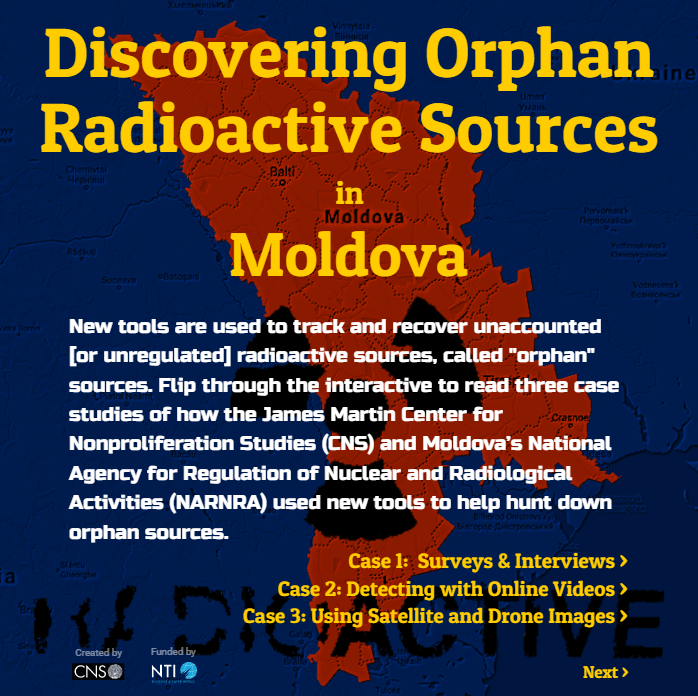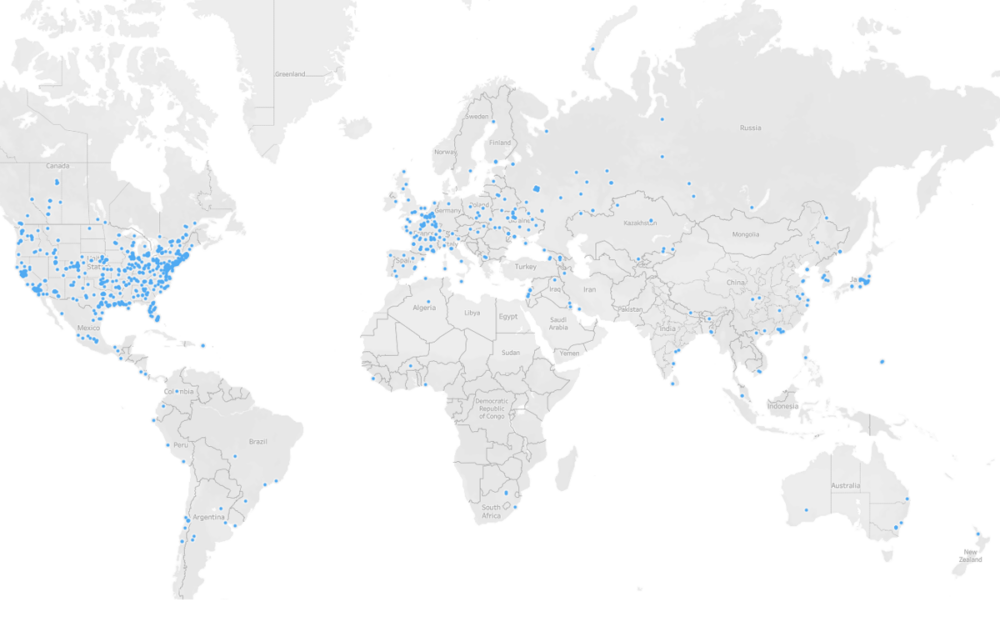
Margarita Kalinina-Pohl
Senior Program Manager and Research Associate
About the image
In the Republic of Moldova, as in other post-Soviet countries, one can find legacy Soviet-era military helicopters, airplanes, and other hardware on display in open-air private museums and city parks. Unknown to most visitors, these disabled aging tools of war can contain small amounts of radioactive material in their controls, gauges, and electronics. In many countries, including the Republic of Moldova, regulatory agencies face challenges in locating radioactive sources – radioactive material that is permanently sealed in a capsule or bonded and in a solid form – currently unaccounted for within their borders. Such radioactive sources outside of regulatory control are called “orphan” sources. 1
There are several methods established by the International Atomic Energy Agency to search for and recover orphan sources, including physical and administrative searches. These methods can be expensive and time-consuming. Therefore, other innovative methods such as network analysis, online surveys, and open-source searches utilizing new tools, such as geospatial analysis, aerial images, social media, as well as YouTube videos, can be used to enhance the national regulators’ ability to track down and secure orphan or abandoned radioactive sources and prevent them from potentially falling into the hands of terrorists or other nefarious actors.
CNS partnered with Moldova’s National Agency for Regulation of Nuclear and Radiological Activities (NARNRA) to track down radioactive material using new tools. The interactive covers three examples of how new tools enhance NARNRA’s ability to locate and recover orphan sources.
Click to view in full-screen.
Radioactive material, usually in the form of metal-encapsulated sources, is used in specialized equipment for a variety of medical and industrial purposes. For security and safety reasons, these radioactive sources are typically subject to government regulatory control. Orphan radioactive sources which are not under regulatory control pose a serious risk to both public safety and security, as they can be picked up by unaware members of the public, found in scrap metal, stolen or intentionally obtained by terrorists for use in a radiological dispersal device (RDD) or “dirty bomb”. In 2015, Moldovan smugglers attempted to sell cesium-133 (Cs-133) to an undercover agent posing as a potential buyer, as a precursor to the possible sale of radioactive Cs-137. When interviewed, one smuggler expressed his hope that the Cs-137 would be used by ISIS in a dirty bomb against U.S. citizens. 2 The CNS Global Incidents and Trafficking Database cites other cases involving nuclear and radioactive materials in Moldova which were either discovered accidentally or seized by authorities. 3
Upon the collapse of the former Soviet Union in 1991, regulatory documentation for radioactive sources and material held in the Soviet Union was not transferred to successor states like the Republic of Moldova. As national economies deteriorated in the 1990s, enterprises went bankrupt and many specialists returned to Russia or emigrated to other countries, resulting in the remaining documentation and institutional memory being lost. This forced newly established regulatory authorities in post-Soviet states to build radioactive source inventory data from the ground up. While these nuclear regulators have diligently built inventories and attempted to register all radioactive sources within their borders, the scope of the task has created institutional challenges resulting in a subset of radioactive materials still outside of regulatory controls.
In their journey to track down orphan sources, national regulators must work as both inspectors and detectives. As inspectors, they work with organizations and enterprises to register sources and ensure proper handling and disposal. As detectives, they look for unregistered sources by interviewing people, conducting field surveys, and reviewing published literature. Once they have a lead, regulators transition from what the International Atomic Energy Agency (IAEA) calls an administrative search to a physical search for the orphan source, where they head out into the field with radiation detection equipment.
Unfortunately, due to budgetary constraints, Moldova’s National Agency for Regulation of Nuclear and Radiological Activities (NARNRA) employs only a handful of people. Even with the help of international aid, NARNRA lacks the technical and personnel resources to conduct large-scale orphan source search and recovery operations. Fortunately, innovative methods such as network analysis, online surveys, and open-source searches utilizing new tools, such as geospatial analysis, aerial images, social media, as well as YouTube videos, can help supplement traditional IAEA methods by helping to refine the targets for administrative and physical searches. This makes the workload more manageable for smaller regulatory agencies.
Innovative methods augment traditional methods in a number of ways. For example, much of the institutional knowledge about Soviet enterprises rests within an older population, many of whom are retired and live outside of Moldova, but still present on social media. Network analysis techniques can integrate information about these individuals, their employers, and related enterprises that used or continue using radioactive sources to locate key people and entities that may have knowledge of orphan sources. Network analysis examines how different pieces of data interact with and relate to each other, in this case helping the CNS team identify people of special interest. Once identified, online surveys facilitate interaction with these individuals utilizing a systematic method for data collection. Additionally, prompted by these innovative approaches, NARNRA inspectors have used satellite and aerial imagery and other search techniques, such as drones, to identify large equipment that typically housed radioactive sources, and have identified smaller pieces of equipment by using photographs and YouTube videos posted online.
The James Martin Center for Nonproliferation Studies (CNS) partnered with NARNRA to help track down radioactive material with the use of these innovative tools and methods. Using its unique experience in the new technologies sphere, CNS developed a tool kit to help small regulators like NARNRA locate orphan sources and worked with them to increase their awareness of new tools and open source techniques. With the help of the abovementioned tools and techniques, regulators recovered over 600 low-activity sources and discovered several new facilities that lacked the required licenses for radioactive sources. NARNRA continues to use this acquired know-how in its search for orphan sources and has shared its experience with peers from other countries.
The application of innovative methods with the help of new tools has proven beneficial in Moldova. While network analysis, social media searches, satellite and aerial images, and online surveys cannot replace traditional search and recovery methods, they can be a force multiplier, streamlining the use of traditional methods. New tools and innovative methods help target the efforts of inspectors, indicating where and how traditional methods should be applied. While inspectors must still go into the field to physically locate and recover the sources, new tools can help minimize the number of unnecessary field inspections and operations. They can also reveal new information, locating facilities and enterprises that inspectors were not previously aware of. They allow inspectors to pursue new lines of inquiry, demonstrating the value new tools can bring to regulatory bodies.
Sign up for our newsletter to get the latest on nuclear and biological threats.
“The bottom line is that the countries and areas with the greatest responsibility for protecting the world from a catastrophic act of nuclear terrorism are derelict in their duty,” the 2023 NTI Index reports.
The only public database of its kind, includes global nuclear & radiological security trends, findings, policy recommendations, and interactive visualizations.
Archives of Global Incidents and Trafficking Database, 2013-2018. (CNS)


